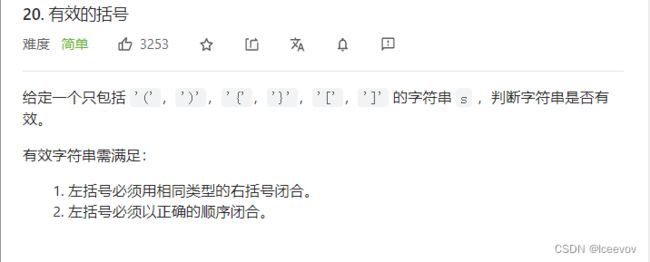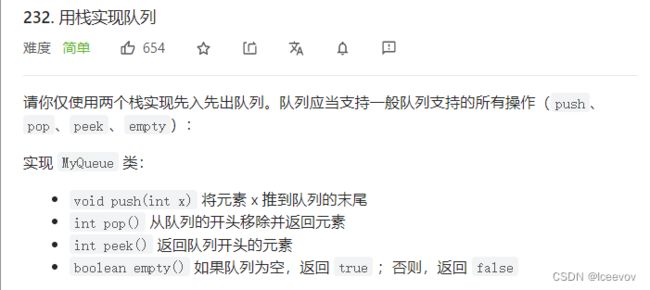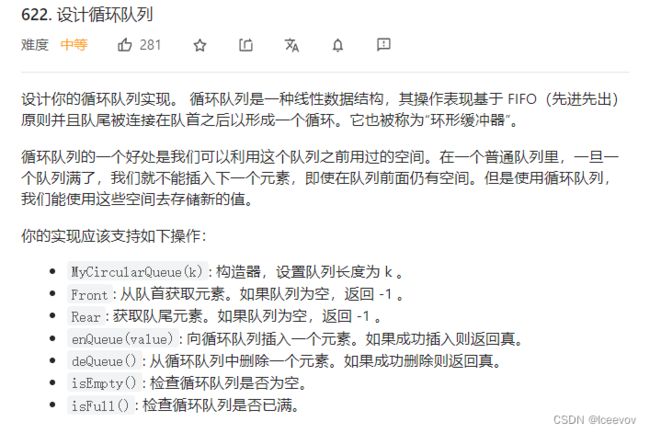【数据结构】LeetCode栈和队列经典题型
目录
1.有效的括号
2.用队列实现栈编辑
3.用栈实现队列编辑
4.设计循环队列
1.有效的括号
思路:因为左括号要和右括号顺序和类型都匹配,那么当从第一个右括号开始就要和左括号里最后一个匹配,如果匹配就下一个继续往后走。这样我们非常容易想到栈,左括号入栈,当遇到右括号就出栈,然后判断是否匹配,若不匹配就返回false,匹配就看下一个,直到栈为空。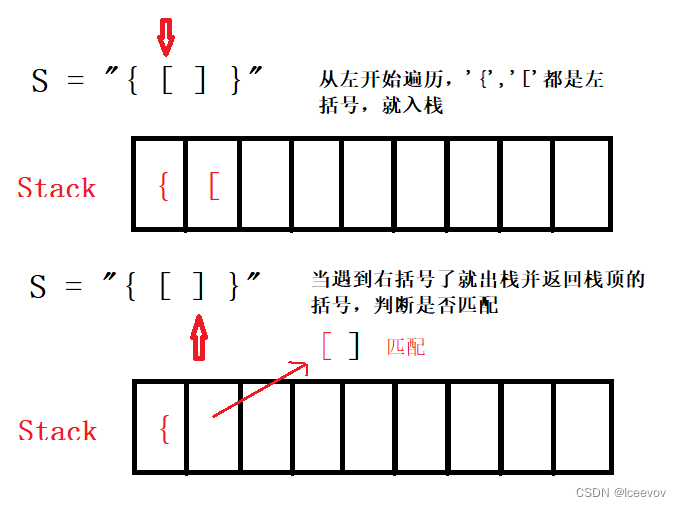
代码:因为这里是C语言实现所有需要创建栈来使用,就用前面讲过的栈来用
typedef char STDataType;
//栈必须符合后进先出的原则
//创建动态栈空间
typedef struct Stack
{
STDataType* val;
int top;//栈顶
int capacity;//栈容量
}ST;
//初始化
void StackInit(ST* ps);
//销毁栈空间
void StackDestroy(ST* ps);
//插入数据
void StackPush(ST* ps,STDataType x);
//删除数据
void StackPop(ST* ps);
//拿出栈顶的数据
STDataType StackTop(ST* ps);
//判断栈是否为空
bool StackEmpty(ST* ps);
//计算栈的长度
int StackSize(ST* ps);
//初始化
void StackInit(ST* ps)
{
assert(ps);
ps->val = NULL;
ps->top = 0;
ps->capacity = 0;
}
//销毁栈空间
void StackDestroy(ST* ps)
{
assert(ps);
free(ps->val);
ps->val = NULL;
ps->top = ps->capacity = 0;
}
//插入数据
void StackPush(ST* ps, STDataType x)
{
assert(ps);
//先看空间够不够
if (ps->top == ps->capacity)
{
int newCapacity = ps->capacity == 0 ? 4 : ps->capacity * 2;
STDataType* tmp = (STDataType*)realloc(ps->val,sizeof(STDataType) * newCapacity);
if (tmp == NULL)
{
perror("realloc");
return;
}
ps->val = tmp;
ps->capacity = newCapacity;
}
//栈顶的数据元素给值
ps->val[ps->top] = x;
++ps->top;
}
//删除数据
void StackPop(ST* ps)
{
assert(ps);
//判断栈是否为空
assert(!StackEmpty(ps));
--ps->top;
}
//找到栈顶的数据
STDataType StackTop(ST* ps)
{
assert(ps);
assert(!StackEmpty(ps));
return ps->val[ps->top-1];
}
//判断栈是否为空
bool StackEmpty(ST* ps)
{
assert(ps);
return ps->top == 0;
}
//计算栈的长度
int StackSize(ST* ps)
{
assert(ps);
return ps->top;
}
bool isValid(char * s){
ST st;
StackInit(&st);
while(*s)
{
if(*s == '(' || *s == '{' || *s == '[')
{
StackPush(&st,*s);
++s;
}
else
{
//在判断右括号之前如果栈里没有东西也返回false
if(StackEmpty(&st))
{
StackDestroy(&st);
return false;
}
//比较
STDataType top = StackTop(&st);
StackPop(&st);
if((top == '(' && *s == ')')
|| (top == '{' && *s == '}')
|| (top == '[' && *s == ']'))
{
++s;
}
else
{
//销毁空间返回false
StackDestroy(&st);
return false;
}
}
}
//如果出来了判断栈是否为空,如果为空的话就代表全部匹配
bool ret = StackEmpty(&st);
StackDestroy(&st);
return ret;
} 2.用队列实现栈
思路:用两个队列来实现后进先出的队列。插入数据时,需要往不为空的队列里插入。删除时需要倒数据,返回栈顶也就是返回队列的尾,判断栈是否为空只需判断两个队列是否为空。下图是移除并返回栈顶元素的思路。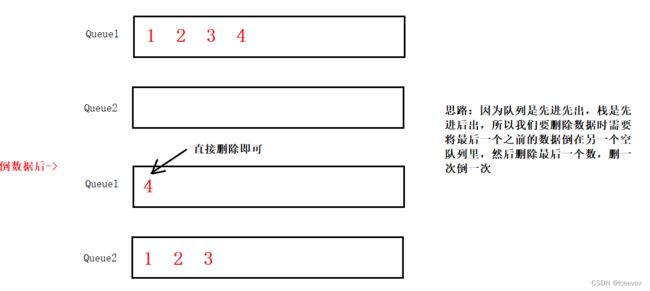
代码:
typedef int QDatatype;
//用链表实现队列
typedef struct QueueNode
{
QDatatype val;
struct QueueNode* next;
}QNode;
//存放链表的头结点和尾结点
typedef struct Queue
{
QNode* head;
QNode* tail;
}Queue;
void QueueInit(Queue* pq);
void QueueDestroy(Queue* pq);
void QueuePush(Queue* pq,QDatatype x);
void QueuePop(Queue* pq);
QDatatype QueueFront(Queue* pq);
QDatatype QueueBack(Queue* pq);
bool QueueEmpty(Queue* pq);
int QueueSize(Queue* pq);
void QueueInit(Queue* pq)
{
assert(pq);
pq->head = pq->tail = NULL;
}
void QueueDestroy(Queue* pq)
{
assert(pq);
QNode* cur = pq->head;
while (cur)
{
QNode* next = cur->next;
free(cur);
cur = next;
}
pq->head = pq->tail = NULL;
}
void QueuePush(Queue* pq, QDatatype x)
{
assert(pq);
//创建一个新结点
QNode* newnode = (QNode*)malloc(sizeof(QNode));
if (newnode == NULL)
{
printf("malloc fail\n");
return;
}
newnode->val = x;
newnode->next = NULL;
//队列为空的创建
if (pq->tail == NULL)
{
pq->head = pq->tail = newnode;
}
//队列不为空的创建
else
{
pq->tail->next = newnode;
pq->tail = newnode;
}
}
void QueuePop(Queue* pq)
{
assert(pq);
//判断当前队列是否为空
assert(!QueueEmpty(pq));
//若队列中只有一个结点
if (pq->head->next == NULL)
{
free(pq->head);
pq->head = pq->tail = NULL;
}
//不止一个结点
else
{
QNode* next = pq->head->next;
free(pq->head);
pq->head = next;
}
}
QDatatype QueueFront(Queue* pq)
{
assert(pq);
assert(!QueueEmpty(pq));
return pq->head->val;
}
QDatatype QueueBack(Queue* pq)
{
assert(pq);
assert(!QueueEmpty(pq));
return pq->tail->val;
}
bool QueueEmpty(Queue* pq)
{
assert(pq);
//只用判断头是否为空就行
return pq->head == NULL;
}
int QueueSize(Queue* pq)
{
int size = 0;
QNode* cur = pq->head;
while (cur)
{
++size;
cur = cur->next;
}
return size;
}
typedef struct {
Queue q1;
Queue q2;
} MyStack;
MyStack* myStackCreate() {
MyStack* obj = (MyStack*)malloc(sizeof(MyStack));
//初始化
QueueInit(&obj->q1);
QueueInit(&obj->q2);
//返回obj的地址
return obj;
}
void myStackPush(MyStack* obj, int x) {
//往不为空的队列里插入数据,空的队列用来倒数据
if(!QueueEmpty(&obj->q1))
{
QueuePush(&obj->q1,x);
}
else
{
QueuePush(&obj->q2,x);
}
}
int myStackPop(MyStack* obj) {
//讲有数据的倒到空的队列里,留一个然后删除留的那一个
//首先假设q1为空,q2不为空
//找到空的和不空的队列
Queue* empty = &obj->q1;
Queue* notempty = &obj->q2;
if(!QueueEmpty(&obj->q1))
{
empty = &obj->q2;
notempty = &obj->q1;
}
//倒数据
int size = QueueSize(notempty);
while(size>1)
{
//插入到空的队列中去
QueuePush(empty,QueueFront(notempty));
QueuePop(notempty);
size--;
}
//先传给top再删除最后剩下的这个数据
int top = QueueFront(notempty);
QueuePop(notempty);
return top;
}
int myStackTop(MyStack* obj) {
//只需要返回,不用删除,可以不用倒,直接找非空的最后一个数
Queue* empty = &obj->q1;
Queue* notempty = &obj->q2;
if(!QueueEmpty(&obj->q1))
{
empty = &obj->q2;
notempty = &obj->q1;
}
int top = QueueBack(notempty);
return top;
}
bool myStackEmpty(MyStack* obj) {
return QueueEmpty(&obj->q1) && QueueEmpty(&obj->q2);
}
void myStackFree(MyStack* obj) {
//先释放两个队列
QueueDestroy(&obj->q1);
QueueDestroy(&obj->q2);
//再释放obj
free(obj);
}3.用栈实现队列
思路:上面一题的数据需要在队列之间来回倒,这里不需要,因为队列是后进先出的,当我们将栈1的数据倒到栈2里时栈2里的数据就是逆序,若要删除只需从栈顶依次删除下来,符合队列的先进先出规则,插入数据时需要注意的是,我们一个栈只入栈,一个栈只出,只往栈1里入栈,栈2只出,当栈2有数据时就不能倒,为空时才能倒。
代码:
typedef char STDataType;
//栈必须符合后进先出的原则
//创建动态栈空间
typedef struct Stack
{
STDataType* val;
int top;//栈顶
int capacity;//栈容量
}ST;
//初始化
void StackInit(ST* ps);
//销毁栈空间
void StackDestroy(ST* ps);
//插入数据
void StackPush(ST* ps,STDataType x);
//删除数据
void StackPop(ST* ps);
//拿出栈顶的数据
STDataType StackTop(ST* ps);
//判断栈是否为空
bool StackEmpty(ST* ps);
//计算栈的长度
int StackSize(ST* ps);
//初始化
void StackInit(ST* ps)
{
assert(ps);
ps->val = NULL;
ps->top = 0;
ps->capacity = 0;
}
//销毁栈空间
void StackDestroy(ST* ps)
{
assert(ps);
free(ps->val);
ps->val = NULL;
ps->top = ps->capacity = 0;
}
//插入数据
void StackPush(ST* ps, STDataType x)
{
assert(ps);
//先看空间够不够
if (ps->top == ps->capacity)
{
int newCapacity = ps->capacity == 0 ? 4 : ps->capacity * 2;
STDataType* tmp = (STDataType*)realloc(ps->val,sizeof(STDataType) * newCapacity);
if (tmp == NULL)
{
printf("realloc fail\n");
return;
}
ps->val = tmp;
ps->capacity = newCapacity;
}
//栈顶的数据元素给值
ps->val[ps->top] = x;
ps->top++;
}
//删除数据
void StackPop(ST* ps)
{
assert(&ps);
//判断栈是否为空
assert(!StackEmpty(ps));
ps->top--;
}
//拿出栈顶的数据
STDataType StackTop(ST* ps)
{
assert(ps);
assert(!StackEmpty(ps));
return ps->val[ps->top-1];
}
//判断栈是否为空
bool StackEmpty(ST* ps)
{
assert(ps);
return ps->top == 0;
}
//计算栈的长度
int StackSize(ST* ps)
{
assert(ps);
return ps->top;
}
typedef struct {
ST s1;
ST s2;
} MyQueue;
MyQueue* myQueueCreate() {
MyQueue* obj = (MyQueue*)malloc(sizeof(MyQueue));
StackInit(&obj->s1);
StackInit(&obj->s2);
return obj;
}
void myQueuePush(MyQueue* obj, int x) {
//默认s1栈专门进队列,s2专门出队列
StackPush(&obj->s1,x);
}
int myQueuePop(MyQueue* obj) {
//s2为空时,将s1的数据倒入s2中
if(StackEmpty(&obj->s2))
{
//栈底的数据留着直接返回并删除就行
while(StackSize(&obj->s1)>1)
{
StackPush(&obj->s2,StackTop(&obj->s1));
StackPop(&obj->s1);
}
int top = StackTop(&obj->s1);
StackPop(&obj->s1);
return top;
}
//s2不为空时从s2栈顶开始取数据
else
{
int top = StackTop(&obj->s2);
StackPop(&obj->s2);
return top;
}
}
int myQueuePeek(MyQueue* obj) {
//若s2为空时,将s1的数据全部倒入s2中
if(StackEmpty(&obj->s2))
{
//将全部s1倒入s2
while(StackSize(&obj->s1))
{
StackPush(&obj->s2,StackTop(&obj->s1));
StackPop(&obj->s1);
}
}
//返回s2的栈顶
int top = StackTop(&obj->s2);
return top;
}
bool myQueueEmpty(MyQueue* obj) {
return StackEmpty(&obj->s1) && StackEmpty(&obj->s2);
}
void myQueueFree(MyQueue* obj) {
StackDestroy(&obj->s1);
StackDestroy(&obj->s2);
free(obj);
}4.设计循环队列
思路: 当队列为循环状态时,我们头空的情况下头等于尾,那么当我们满的情况下呢?头还等于尾吗?于是我们设计了下面这个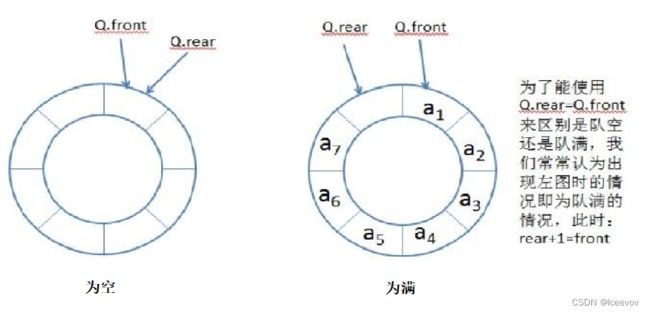
这里我们用数组来实现较为简单 把上面那个圆展开就成了一个数组。
当插入数据时插入在tail位置,然后tail++,不过每次插入时需要判断是否已满,删除数据时将head向后移即可删除。不过需要注意的是当在边界时我们需要处理tail和head。
代码:
//用数组实现
typedef struct {
int* a;
int k;
int head;
int tail;
} MyCircularQueue;
//函数声明
bool myCircularQueueIsEmpty(MyCircularQueue* obj);
bool myCircularQueueIsFull(MyCircularQueue* obj);
MyCircularQueue* myCircularQueueCreate(int k) {
MyCircularQueue* obj = (MyCircularQueue*)malloc(sizeof(MyCircularQueue));
obj->a = (int*)malloc(sizeof(int)*(k+1));
obj->k = k;
obj->head = obj->tail = 0;
return obj;
}
bool myCircularQueueEnQueue(MyCircularQueue* obj, int value) {
//首先判断是否满了
if(myCircularQueueIsFull(obj))
return false;
obj->a[obj->tail] = value;
obj->tail++;
//特殊处理,当tail>k时
if(obj->tail == obj->k+1)
obj->tail = 0;
return true;
}
bool myCircularQueueDeQueue(MyCircularQueue* obj) {
//判断是否为空
if(myCircularQueueIsEmpty(obj))
return false;
//将head向后移
obj->head++;
//当head在最后一位时需要特殊处理
if(obj->head == obj->k+1)
obj->head = 0;
return true;
}
int myCircularQueueFront(MyCircularQueue* obj) {
if(myCircularQueueIsEmpty(obj))
return -1;
return obj->a[obj->head];
}
int myCircularQueueRear(MyCircularQueue* obj) {
if(myCircularQueueIsEmpty(obj))
return -1;
//当tail为0时返回队尾的数
if(obj->tail == 0)
return obj->a[obj->k];
//返回tail前面的数据
else
return obj->a[obj->tail-1];
}
bool myCircularQueueIsEmpty(MyCircularQueue* obj) {
//当head=tail时为空
return obj->head == obj->tail;
}
bool myCircularQueueIsFull(MyCircularQueue* obj) {
//如果tail在head前一个就说明满了
int head = obj->head;
int tail = obj->tail + 1
;
//当tail在队尾时处理一下
if(tail == obj->k+1)
tail = 0;
if(head == tail)
return true;
else
return false;
}
void myCircularQueueFree(MyCircularQueue* obj) {
//先释放数组
free(obj->a);
//再释放结构体
free(obj);
}